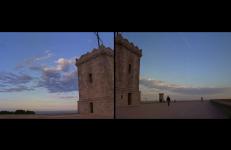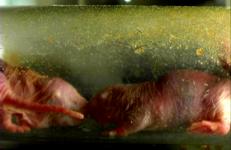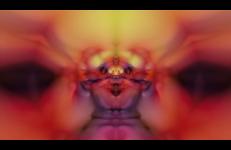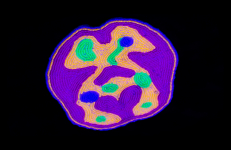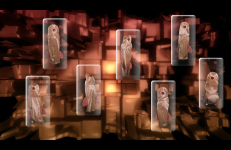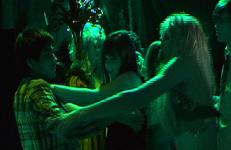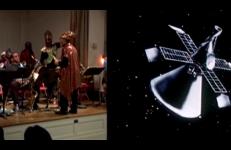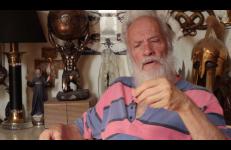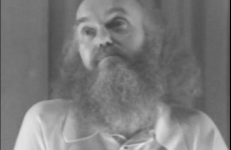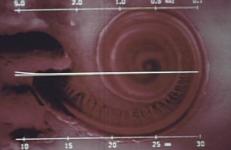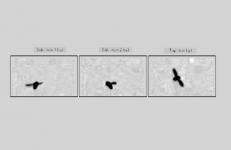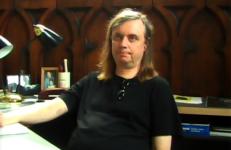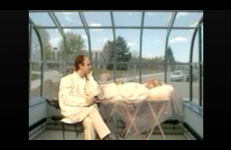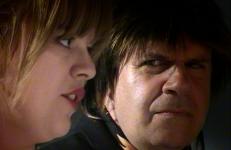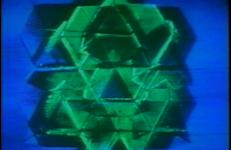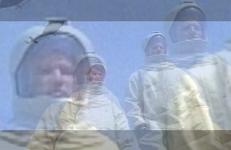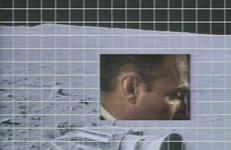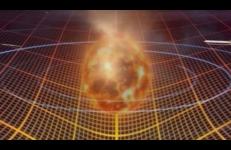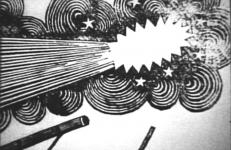Jacqueline Goss and Jenny Perlin retrace the journey of two 18th-century astronomers tasked with determining the true length of the meter. From the Mediterranean Sea to the English Channel, The Measures explores the metric system’s origins during the violence and upheavals of the French Revolution. Along the way, Goss and Perlin consider the intertwining of political and personal turmoil, the failures of standardization, and the subtleties of collaboration.
Science
Naked shows a colony of naked mole rats living in a laboratory. This rare and highly socialized species demonstrates modes of behavior that in uncanny ways seem human-like. The mole rats are the most inbred species on the planet, and have the longest life span of any laboratory animal. The film zeroes in on aspects of their existence (overcrowded conditions, violence, tenderness) that have parallels in the life of human society.
Nebula is a hallucinogenically immersive spectacle: a complex, long-form audio-visual composition, which pays playful homage to science fiction fantasies. Captured for video by means of stop-motion photography, objects made of glass, glitter and tulle, are nestled within a kaleidoscopic flow of computer-generated imagery. Drawing from Thomas Wilfred's Clavilux color organs as well as experimental abstract filmmakers such as Mary Ellen Bute, and James and John Whitney, Nebula also recalls liquid light shows and the marvelous sightings of the Hubble Space Telescope.
Nebula is a hallucinogenically immersive spectacle: a complex, long-form audio-visual composition, which pays playful homage to science fiction fantasies. Captured for video by means of stop-motion photography, objects made of glass, glitter and tulle, are nestled within a kaleidoscopic flow of computer-generated imagery. Drawing from Thomas Wilfred's Clavilux color organs as well as experimental abstract filmmakers such as Mary Ellen Bute, and James and John Whitney, Nebula also recalls liquid light shows and the marvelous sightings of the Hubble Space Telescope.
Theo Cuthand and his mother Ruth Cuthand have a candid conversation about Theo's last hospitalization for Bipolar Disorder in 2007. While Theo only knew his manic episode from the inside, Ruth had to deal with caregiving decisions and trying to find help. While they reminisce they also have to reckon with the feelings of animosity that arose between them during these events.
Co-directed with Ruth Cuthand.
In the solar system 18 SCORPII, located some 45.3 light years from Earth at the northern edge of the Scorpius constellation, two planets have evolved cultures of profound mutual symbiotic reliance. The ecstatic dance-like interaction between the almost inert Kalataka and the exhausted but entranced Tarzanians, is extraordinarily beautiful, building to the climactic effusion of Kalataka sporge.
Produced in Tempe, Arizona this cosmic symbiosis is rendered with the help of masks, costumes, and campy visual effects.
In the solar system 18 SCORPII, located some 45.3 light years from Earth at the northern edge of the Scorpius constellation, two planets have evolved cultures of profound mutual symbiotic reliance. The ecstatic dance-like interaction between the almost inert Kalataka and the exhausted but entranced Tarzanians, is extraordinarily beautiful, building to the climactic effusion of Kalataka sporge.
Produced in Tempe, Arizona this cosmic symbiosis is rendered with the help of masks, costumes, and campy visual effects.
This documentary charts a trip around Baja California to the Tropic of Cancer line on the summer solstice. Largely photographed in-camera, the film develops its narrative drive through the rhythm of shot length and composition. Aided by an original score from Beth Custer and a wicked sound design by Jeremiah Moore that utilizes sounds form the Cassini space probe, the piece takes on a humorously sinister tone; as if the historical marker were an alien landing
Made at the San Francisco Art Institute with my students, this tuneful picture transports the viewer to the planet Mars as three attractive teens seek funding for an expedition into adulthood. Along the way they and we encounter the ups and downs of human relations and otherworldly intercourse. A family picture with timeless values, this foray into fantasy land on a tight budget should please the young at heart or old in body in unexpected ways. Although this trip is short on funding but big in concept it’s really quite a ride and looks like a million bucks for the vision impaired.
“A documentary about the Arkestra, but it's one whose presentation reflects the multilevel approach Sun Ra had to music and life in general. Jump cuts and split screens dot the visual stream with home movie footage from the Arkestra in Egypt during the 1970s to the Arkestra of today led by Marshall Allen. Director Ephraim Asili wisely divides the 40 minutes into distinct chapters, illustrating each with band interviews, live footage, visuals of planets and NASA launches, and his voice quoting writings from Ra.
Primate Cinema: Apes as Family is a drama made expressly for chimpanzees – and the chimps' reaction to its screening at the Edinburgh Zoo. Chimpanzees watch television as a form of enrichment in captivity. But no filmmaker had made a film for a specifically ape audience.
Ram Dass, born Richard Alpert, was a spiritual guru and crucial figure in the early research of psychedelics alongside Timothy Leary in the 1960s–70s. In the early 70s, he gave a lecture at the Art Institute of Chicago. He began by mentioning a recent interaction with Sidney Cohen with whom he had co-authored the book LSD (1966). Ram Dass discussed being on a panel with Cohen about substance use in Washington D.C.
"The human ear. A gatherer of energy. A gatherer of sound. RPMs and BPMs. Satellites go up to the sky."
In the video Satellite, Nelson Henricks combines found footage and techno beats to question western society's ongoing obsession with science, technology and the future. Juxtaposing images derived from old educational films with absurd, aphoristic slogans, Henricks offers up a witty, entertaining and provocative commentary of our need to make sense of everything, at any cost.
The Soft Science “Cinema of Attractions” is a series of short movies by scientists. Commission and concept by Rachel Mayeri, electronic compositions and musical accompaniment by Joe Milutis. Many of the videos can be found on the web, posted for public appreciation of a scientist's lab work, as instructional material, or for communication to peers as data. As "data," the videos are non-narrative, scientific information.
The Soft Science “Cinema of Attractions” is a series of short movies by scientists. Commission and concept by Rachel Mayeri, electronic compositions and musical accompaniment by Joe Milutis. Many of the videos can be found on the web, posted for public appreciation of a scientist's lab work, as instructional material, or for communication to peers as data. As "data," the videos are non-narrative, scientific information.
Commissioned by Ben Russell’s “Tales from the Space Age” screening for MoogFest, Asheville, NC, USA, May 2016. Space Age II is a short video responding to JG Ballard's short story Memories of the Space Age. Memories become still as migration south moves forward. With vocal accompaniment by Jenny Graf.
On May 11 2004, Steve Kurtz phoned 911 to report Hope, his wife of 20 years, was unresponsive. When paramedics came to his house, one of them noticed that Kurtz had laboratory equipment, which he used in his art exhibits. The paramedics reported this to police and the FBI sealed off his house.
Authorities later said that Kurtz's wife had died of "heart failure," but he wasn't allowed to return to his home for two days while the FBI confiscated his equipment, and biological samples. They also carted off his books, personal papers and computer.
On May 11 2004, Steve Kurtz phoned 911 to report Hope, his wife of 20 years, was unresponsive. When paramedics came to his house, one of them noticed that Kurtz had laboratory equipment, which he used in his art exhibits. The paramedics reported this to police and the FBI sealed off his house.
Authorities later said that Kurtz's wife had died of "heart failure," but he wasn't allowed to return to his home for two days while the FBI confiscated his equipment, and biological samples. They also carted off his books, personal papers and computer.
Part cloning experiment, part documentary, Stories from the Genome follows an unnamed CEO-geneticist whose company sequenced the Human Genome in 2003 — a genome that secretly was his own. Not satisfied with this feat, the scientist self-replicates, producing a colony of clone-scientists to save himself from Alzheimer’s. The animated video switches between misadventures in cloning, and a history of equally improbable theories of human development.
This title is only available on Soft Science.
Storyteller recomposes aerial shots from the Las Vegas casino skyline to create a slick, artificial world, reminiscent of science fiction. At first glance, the viewer might think of jewelry-like space ships floating slowly through the universe. When the camera zooms in on buildings and architecture, the detailed glitter and kitsch of the city hypnotically reveals something of pure beauty and madness.
With Strain Andromeda The, video artist Anne McGuire has created an awesome and spellbinding film that throws everything from story structure to character motivation into question. Put simply, McGuire has taken Robert Wise's entire 1971 virus from outer space classic The Andromeda Strain and re-edited it shot-by-shot precisely in reverse, so that the last shot appears first and the first last, though nothing is actually running backwards.
Strained Andromeda Strain is a frame by frame re-edit of Robert Wise's 131-minute sci-fi biological thriller into a 7-minute anxious oscillation.
Thornton asks viewers to question how one sees “space" — whether literally or figuratively — and what is being revealed? Images of a sonogram session grant viewers access to what is typically reserved for medical analysis — “inner space.”
"In The Very Very End, Barber points to his medium's plastic possibility by somehow traveling into the future and the past, nodding to Neville Shute's apocalyptic 1957 novel On The Beach, while setting an end-of-days story in a 21st Century holiday resort.
Since comets have been recorded, they've augured catastrophe, messiahs, upheaval and end times. A short film about these meteoric ice-cored fireballs and their historic ties to divination that combines imagery of 15th-18th Century European broadsides with NASA Jet Propulsion Laboratory footage.




